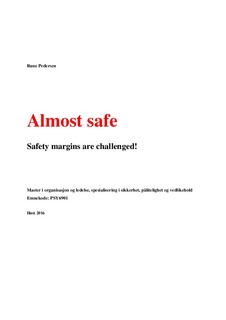| dc.description.abstract | This thesis is a qualitative empirical case-study. The central themes to be elucidated were factors that can avoid a negative decrease in safety margins in risky work. Data for this study was collected from individual semi-structured interviews at various locations in Norway and from discussions in a focus group abroad during 2016. The respondents were a firefighter, a military leader, a helicopter pilot, a safety manager, an entrepreneur and a counterterrorism police unit. The study comprises relatively few respondents so the results are not expected to provide essential theoretical or methodical contributions to the field of safety, but it offers an empirical contribution which tests and challenges available theoretical hypotheses related to safety margins. The data analysis identified the following factors which all six (the unit is regarded as one in this case) of the respondents in general regarded as most important for avoiding a negative decrease in safety margins in risky work: The importance of leadership, end state, experience transfer by communication, training, exercises, learning and deviations, risk analysis, procedures and sharp-end involvement, decision making and management of complexity and safety cultures. The findings from the case study was compared to the principles and explanations found in the literature. | nb_NO |
